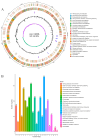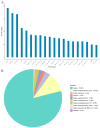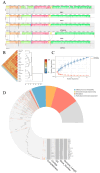Genome-Driven Functional Validation of Bacillus amyloliquefaciens Strain MEPW12: A Multifunctional Endophyte for Sustainable Sweet Potato Cultivation
- PMID: 40572210
- PMCID: PMC12195239
- DOI: 10.3390/microorganisms13061322
Genome-Driven Functional Validation of Bacillus amyloliquefaciens Strain MEPW12: A Multifunctional Endophyte for Sustainable Sweet Potato Cultivation
Abstract
Sweet potato (Ipomoea batatas (L.) Lam.), as an important crop, is rich in polyphenols, vitamins, minerals, and other nutrients in its roots and leaves and is gradually gaining popularity. The use of endophytic bacteria to improve the quality of sweet potato can protect the environment and effectively promote the sustainable development of the sweet potato industry. In this study, 12 strains of endophytic bacteria were isolated from sweet potato. Through nitrogen fixation, phosphorus solubilization, indoleacetic acid production, siderophore production, ACC deaminase production, and carboxymethyl cellulose production, three strains with multiple biological activities were screened out. Among them, MEPW12 had the most plant growth-promoting functions. In addition, MEPW12 promoted host chlorophyll accumulation and inhibited pathogen growth and colonization in sweet potato roots and can utilize various carbon sources and salts for growth. It can also grow in extreme environments of high salt and weak acid. MEPW12 was identified as Bacillus amyloliquefaciens with a genome size of 3,928,046 bp and a GC content of 46.59%. After the annotation of multiple databases, it was found that MEPW12 had multiple enzymatic activities and metabolic potential. Comparative genomics and pan-genomics analyses revealed that other Bacillus sp. strains of MEPW12 have similar functions. However, due to adaptation to different growth environments, there are still genomic differences and changes. Inoculation with MEPW12 induced the high expression of IbGH3.10, IbERF1, and other genes, thereby promoting the growth of sweet potatoes. Bacillus amyloliquefaciens strain MEPW12 is a sweet potato endophyte with multiple growth-promoting functions, which can promote the growth of sweet potato seedlings. This study provides new microbial resources for developing microbial agents and improving the quality of sweet potatoes.
Keywords: endophyte; genome; growth promoting bacteria; pan-genomic analysis; sweet potato.
Conflict of interest statement
The authors declare no conflict of interest.
Figures









Similar articles
-
Home treatment for mental health problems: a systematic review.Health Technol Assess. 2001;5(15):1-139. doi: 10.3310/hta5150. Health Technol Assess. 2001. PMID: 11532236
-
Cost-effectiveness of using prognostic information to select women with breast cancer for adjuvant systemic therapy.Health Technol Assess. 2006 Sep;10(34):iii-iv, ix-xi, 1-204. doi: 10.3310/hta10340. Health Technol Assess. 2006. PMID: 16959170
-
Systemic pharmacological treatments for chronic plaque psoriasis: a network meta-analysis.Cochrane Database Syst Rev. 2021 Apr 19;4(4):CD011535. doi: 10.1002/14651858.CD011535.pub4. Cochrane Database Syst Rev. 2021. Update in: Cochrane Database Syst Rev. 2022 May 23;5:CD011535. doi: 10.1002/14651858.CD011535.pub5. PMID: 33871055 Free PMC article. Updated.
-
Sertindole for schizophrenia.Cochrane Database Syst Rev. 2005 Jul 20;2005(3):CD001715. doi: 10.1002/14651858.CD001715.pub2. Cochrane Database Syst Rev. 2005. PMID: 16034864 Free PMC article.
-
Diagnostic test accuracy and cost-effectiveness of tests for codeletion of chromosomal arms 1p and 19q in people with glioma.Cochrane Database Syst Rev. 2022 Mar 2;3(3):CD013387. doi: 10.1002/14651858.CD013387.pub2. Cochrane Database Syst Rev. 2022. PMID: 35233774 Free PMC article.
References
Grants and funding
LinkOut - more resources
Full Text Sources
Miscellaneous

